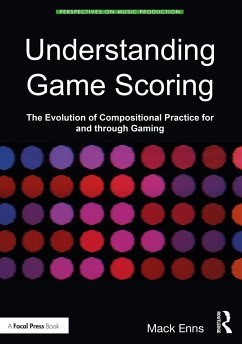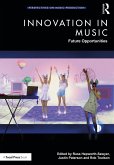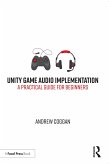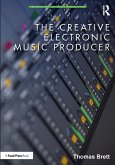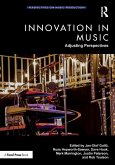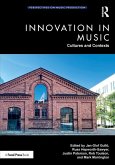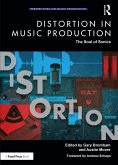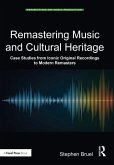- Broschiertes Buch
- Merkliste
- Auf die Merkliste
- Bewerten Bewerten
- Teilen
- Produkt teilen
- Produkterinnerung
- Produkterinnerung
Understanding Game Scoring explores the unique collaboration between gameplay and composition that defines musical scoring for video games.
Andere Kunden interessierten sich auch für
![Innovation in Music Innovation in Music]() Innovation in Music74,99 €
Innovation in Music74,99 €![Unity Game Audio Implementation Unity Game Audio Implementation]() Andrew CogganUnity Game Audio Implementation74,99 €
Andrew CogganUnity Game Audio Implementation74,99 €![The Creative Electronic Music Producer The Creative Electronic Music Producer]() Thomas BrettThe Creative Electronic Music Producer52,99 €
Thomas BrettThe Creative Electronic Music Producer52,99 €![Innovation in Music: Adjusting Perspectives Innovation in Music: Adjusting Perspectives]() Innovation in Music: Adjusting Perspectives70,99 €
Innovation in Music: Adjusting Perspectives70,99 €![Innovation in Music Innovation in Music]() Innovation in Music77,99 €
Innovation in Music77,99 €![Distortion in Music Production Distortion in Music Production]() Distortion in Music Production61,99 €
Distortion in Music Production61,99 €![Remastering Music and Cultural Heritage Remastering Music and Cultural Heritage]() Stephen BruelRemastering Music and Cultural Heritage34,99 €
Stephen BruelRemastering Music and Cultural Heritage34,99 €-
-
-
Understanding Game Scoring explores the unique collaboration between gameplay and composition that defines musical scoring for video games.
Hinweis: Dieser Artikel kann nur an eine deutsche Lieferadresse ausgeliefert werden.
Hinweis: Dieser Artikel kann nur an eine deutsche Lieferadresse ausgeliefert werden.
Produktdetails
- Produktdetails
- Perspectives on Music Production
- Verlag: Taylor & Francis Ltd
- Seitenzahl: 148
- Erscheinungstermin: 22. November 2021
- Englisch
- Abmessung: 174mm x 245mm x 11mm
- Gewicht: 370g
- ISBN-13: 9780367492816
- ISBN-10: 0367492814
- Artikelnr.: 62270102
- Herstellerkennzeichnung
- Libri GmbH
- Europaallee 1
- 36244 Bad Hersfeld
- 06621 890
- Perspectives on Music Production
- Verlag: Taylor & Francis Ltd
- Seitenzahl: 148
- Erscheinungstermin: 22. November 2021
- Englisch
- Abmessung: 174mm x 245mm x 11mm
- Gewicht: 370g
- ISBN-13: 9780367492816
- ISBN-10: 0367492814
- Artikelnr.: 62270102
- Herstellerkennzeichnung
- Libri GmbH
- Europaallee 1
- 36244 Bad Hersfeld
- 06621 890
Mack Enns is a Research Assistant Professor at Hong Kong Baptist University, specializing in music design and programming for video games and interactive media, music technology and popular music studies.
Contents
List of Figures
List of Tables
Chapter 1
An Introduction to Game Scoring
Disasterpeace and FEZ: A Case Study of Game Scoring
Music System Overview: Sequence Context Menu
Music System Overview: Scripts Browser
Music System Overview: Main Composition Sequencer
Game Scoring as an Unique Mode of Musical Composition
Methodology and Outline
Chapter 2
Game Scoring's Interactive Multimedia Context
Spatial Emulation, the "Gaming Diegesis" and Game Scoring
Interactivity: A New Element
Audial Responsibility in the Interactive Multimedia Text: A Case Study of
the Score for The Legend of Zelda (1987)
Case Study Conclusions: John Cage and Game Scoring as Aleatoric Composition
Game Scoring Taxonomy: Title Music
Game Scoring Taxonomy: Source Music
Source Music Case Study: Kondo's "Lost Woods" Vs. Vreeland's "Reflection"
Game Scoring Taxonomy: Results Music
Chapter Conclusions
Chapter 3
Game Scoring and Gaming Technology
Case Study: The Nintendo Entertainment System's Sound Hardware
Configuration
Channel Overview: Pulse Wave Channels
Channel Overview: Triangle Wave Channel
Channel Overview: Noise Channel
Channel Overview: Delta Modulation Channel
NES Game Scoring Techniques
NES Game Scoring Techniques: 2-Channel Echo
NES Game Scoring Techniques: Single Channel Echo
NES Game Scoring Techniques: Arpeggio and Psychoacoustic Block Chords
NES Game Scoring Techniques: TWC Kick Drum Sounds
NES Game Scoring Techniques: Melodic Samples
Putting It All Together: The APU Mixer
Case Study Summary
Game Scoring Taxonomy: Logo Jingles
Game Scoring Taxonomy: Loading Music
Game Scoring Taxonomy: Voice Acting and Vocals
Chapter Conclusions
Chapter 4
Game Design and Game Scoring as Software Programming
Game Scoring Taxonomy: Introduction Music
Game Scoring Taxonomy: Demo Music
Game Scoring Taxonomy: Gameplay Music
Gameplay Music: Hub Music
Gameplay Music: Area Music
Area Music Case Study: Game Scoring as Mimetic Music Technology in Tetris
(1984) and Guitar Hero (2005)
Gameplay Music: Area Music, cont.
Gameplay Music: Time System Jingles
Gameplay Music: Battle Music
Gameplay Music: Rest Music
Gameplay Music: Dialogue Music
Dialogue Music Case Study: The Owl and Link's Awakening (1993)
Gameplay Music: Challenge Music
Chapter Conclusions
Chapter 5
Game Scoring: Gameplay as Performance of Aleatoric Composition
Before Video Games: The Aleatoric Tradition
A Note on Sound Effects
Case Study: Super Mario Bros. (World 6-2)
Game Scores Vs. Game Soundtracks: Super Mario Bros. on CD
Case Study Conclusions
Game Scoring Taxonomy: Menu Sound Effects
Mario Menus: A Case Study of Menu Sound Effects in Two Super Mario Games
Menu Sound Effects, Cont.
Game Scoring Taxonomy: Menu Music
Game Scoring Taxonomy: Status Music (Gameplay Music, Cont.)
Game Scoring Taxonomy: Gameplay Sound Effects
Game Scoring Taxonomy: "Ambiences" or Ambient Sound Effects
Chapter Conclusions
Chapter 6
Game Scoring: Conclusion
Future Directions
Significance
Implications
Conclusion
Index
List of Figures
List of Tables
Chapter 1
An Introduction to Game Scoring
Disasterpeace and FEZ: A Case Study of Game Scoring
Music System Overview: Sequence Context Menu
Music System Overview: Scripts Browser
Music System Overview: Main Composition Sequencer
Game Scoring as an Unique Mode of Musical Composition
Methodology and Outline
Chapter 2
Game Scoring's Interactive Multimedia Context
Spatial Emulation, the "Gaming Diegesis" and Game Scoring
Interactivity: A New Element
Audial Responsibility in the Interactive Multimedia Text: A Case Study of
the Score for The Legend of Zelda (1987)
Case Study Conclusions: John Cage and Game Scoring as Aleatoric Composition
Game Scoring Taxonomy: Title Music
Game Scoring Taxonomy: Source Music
Source Music Case Study: Kondo's "Lost Woods" Vs. Vreeland's "Reflection"
Game Scoring Taxonomy: Results Music
Chapter Conclusions
Chapter 3
Game Scoring and Gaming Technology
Case Study: The Nintendo Entertainment System's Sound Hardware
Configuration
Channel Overview: Pulse Wave Channels
Channel Overview: Triangle Wave Channel
Channel Overview: Noise Channel
Channel Overview: Delta Modulation Channel
NES Game Scoring Techniques
NES Game Scoring Techniques: 2-Channel Echo
NES Game Scoring Techniques: Single Channel Echo
NES Game Scoring Techniques: Arpeggio and Psychoacoustic Block Chords
NES Game Scoring Techniques: TWC Kick Drum Sounds
NES Game Scoring Techniques: Melodic Samples
Putting It All Together: The APU Mixer
Case Study Summary
Game Scoring Taxonomy: Logo Jingles
Game Scoring Taxonomy: Loading Music
Game Scoring Taxonomy: Voice Acting and Vocals
Chapter Conclusions
Chapter 4
Game Design and Game Scoring as Software Programming
Game Scoring Taxonomy: Introduction Music
Game Scoring Taxonomy: Demo Music
Game Scoring Taxonomy: Gameplay Music
Gameplay Music: Hub Music
Gameplay Music: Area Music
Area Music Case Study: Game Scoring as Mimetic Music Technology in Tetris
(1984) and Guitar Hero (2005)
Gameplay Music: Area Music, cont.
Gameplay Music: Time System Jingles
Gameplay Music: Battle Music
Gameplay Music: Rest Music
Gameplay Music: Dialogue Music
Dialogue Music Case Study: The Owl and Link's Awakening (1993)
Gameplay Music: Challenge Music
Chapter Conclusions
Chapter 5
Game Scoring: Gameplay as Performance of Aleatoric Composition
Before Video Games: The Aleatoric Tradition
A Note on Sound Effects
Case Study: Super Mario Bros. (World 6-2)
Game Scores Vs. Game Soundtracks: Super Mario Bros. on CD
Case Study Conclusions
Game Scoring Taxonomy: Menu Sound Effects
Mario Menus: A Case Study of Menu Sound Effects in Two Super Mario Games
Menu Sound Effects, Cont.
Game Scoring Taxonomy: Menu Music
Game Scoring Taxonomy: Status Music (Gameplay Music, Cont.)
Game Scoring Taxonomy: Gameplay Sound Effects
Game Scoring Taxonomy: "Ambiences" or Ambient Sound Effects
Chapter Conclusions
Chapter 6
Game Scoring: Conclusion
Future Directions
Significance
Implications
Conclusion
Index
Contents
List of Figures
List of Tables
Chapter 1
An Introduction to Game Scoring
Disasterpeace and FEZ: A Case Study of Game Scoring
Music System Overview: Sequence Context Menu
Music System Overview: Scripts Browser
Music System Overview: Main Composition Sequencer
Game Scoring as an Unique Mode of Musical Composition
Methodology and Outline
Chapter 2
Game Scoring's Interactive Multimedia Context
Spatial Emulation, the "Gaming Diegesis" and Game Scoring
Interactivity: A New Element
Audial Responsibility in the Interactive Multimedia Text: A Case Study of
the Score for The Legend of Zelda (1987)
Case Study Conclusions: John Cage and Game Scoring as Aleatoric Composition
Game Scoring Taxonomy: Title Music
Game Scoring Taxonomy: Source Music
Source Music Case Study: Kondo's "Lost Woods" Vs. Vreeland's "Reflection"
Game Scoring Taxonomy: Results Music
Chapter Conclusions
Chapter 3
Game Scoring and Gaming Technology
Case Study: The Nintendo Entertainment System's Sound Hardware
Configuration
Channel Overview: Pulse Wave Channels
Channel Overview: Triangle Wave Channel
Channel Overview: Noise Channel
Channel Overview: Delta Modulation Channel
NES Game Scoring Techniques
NES Game Scoring Techniques: 2-Channel Echo
NES Game Scoring Techniques: Single Channel Echo
NES Game Scoring Techniques: Arpeggio and Psychoacoustic Block Chords
NES Game Scoring Techniques: TWC Kick Drum Sounds
NES Game Scoring Techniques: Melodic Samples
Putting It All Together: The APU Mixer
Case Study Summary
Game Scoring Taxonomy: Logo Jingles
Game Scoring Taxonomy: Loading Music
Game Scoring Taxonomy: Voice Acting and Vocals
Chapter Conclusions
Chapter 4
Game Design and Game Scoring as Software Programming
Game Scoring Taxonomy: Introduction Music
Game Scoring Taxonomy: Demo Music
Game Scoring Taxonomy: Gameplay Music
Gameplay Music: Hub Music
Gameplay Music: Area Music
Area Music Case Study: Game Scoring as Mimetic Music Technology in Tetris
(1984) and Guitar Hero (2005)
Gameplay Music: Area Music, cont.
Gameplay Music: Time System Jingles
Gameplay Music: Battle Music
Gameplay Music: Rest Music
Gameplay Music: Dialogue Music
Dialogue Music Case Study: The Owl and Link's Awakening (1993)
Gameplay Music: Challenge Music
Chapter Conclusions
Chapter 5
Game Scoring: Gameplay as Performance of Aleatoric Composition
Before Video Games: The Aleatoric Tradition
A Note on Sound Effects
Case Study: Super Mario Bros. (World 6-2)
Game Scores Vs. Game Soundtracks: Super Mario Bros. on CD
Case Study Conclusions
Game Scoring Taxonomy: Menu Sound Effects
Mario Menus: A Case Study of Menu Sound Effects in Two Super Mario Games
Menu Sound Effects, Cont.
Game Scoring Taxonomy: Menu Music
Game Scoring Taxonomy: Status Music (Gameplay Music, Cont.)
Game Scoring Taxonomy: Gameplay Sound Effects
Game Scoring Taxonomy: "Ambiences" or Ambient Sound Effects
Chapter Conclusions
Chapter 6
Game Scoring: Conclusion
Future Directions
Significance
Implications
Conclusion
Index
List of Figures
List of Tables
Chapter 1
An Introduction to Game Scoring
Disasterpeace and FEZ: A Case Study of Game Scoring
Music System Overview: Sequence Context Menu
Music System Overview: Scripts Browser
Music System Overview: Main Composition Sequencer
Game Scoring as an Unique Mode of Musical Composition
Methodology and Outline
Chapter 2
Game Scoring's Interactive Multimedia Context
Spatial Emulation, the "Gaming Diegesis" and Game Scoring
Interactivity: A New Element
Audial Responsibility in the Interactive Multimedia Text: A Case Study of
the Score for The Legend of Zelda (1987)
Case Study Conclusions: John Cage and Game Scoring as Aleatoric Composition
Game Scoring Taxonomy: Title Music
Game Scoring Taxonomy: Source Music
Source Music Case Study: Kondo's "Lost Woods" Vs. Vreeland's "Reflection"
Game Scoring Taxonomy: Results Music
Chapter Conclusions
Chapter 3
Game Scoring and Gaming Technology
Case Study: The Nintendo Entertainment System's Sound Hardware
Configuration
Channel Overview: Pulse Wave Channels
Channel Overview: Triangle Wave Channel
Channel Overview: Noise Channel
Channel Overview: Delta Modulation Channel
NES Game Scoring Techniques
NES Game Scoring Techniques: 2-Channel Echo
NES Game Scoring Techniques: Single Channel Echo
NES Game Scoring Techniques: Arpeggio and Psychoacoustic Block Chords
NES Game Scoring Techniques: TWC Kick Drum Sounds
NES Game Scoring Techniques: Melodic Samples
Putting It All Together: The APU Mixer
Case Study Summary
Game Scoring Taxonomy: Logo Jingles
Game Scoring Taxonomy: Loading Music
Game Scoring Taxonomy: Voice Acting and Vocals
Chapter Conclusions
Chapter 4
Game Design and Game Scoring as Software Programming
Game Scoring Taxonomy: Introduction Music
Game Scoring Taxonomy: Demo Music
Game Scoring Taxonomy: Gameplay Music
Gameplay Music: Hub Music
Gameplay Music: Area Music
Area Music Case Study: Game Scoring as Mimetic Music Technology in Tetris
(1984) and Guitar Hero (2005)
Gameplay Music: Area Music, cont.
Gameplay Music: Time System Jingles
Gameplay Music: Battle Music
Gameplay Music: Rest Music
Gameplay Music: Dialogue Music
Dialogue Music Case Study: The Owl and Link's Awakening (1993)
Gameplay Music: Challenge Music
Chapter Conclusions
Chapter 5
Game Scoring: Gameplay as Performance of Aleatoric Composition
Before Video Games: The Aleatoric Tradition
A Note on Sound Effects
Case Study: Super Mario Bros. (World 6-2)
Game Scores Vs. Game Soundtracks: Super Mario Bros. on CD
Case Study Conclusions
Game Scoring Taxonomy: Menu Sound Effects
Mario Menus: A Case Study of Menu Sound Effects in Two Super Mario Games
Menu Sound Effects, Cont.
Game Scoring Taxonomy: Menu Music
Game Scoring Taxonomy: Status Music (Gameplay Music, Cont.)
Game Scoring Taxonomy: Gameplay Sound Effects
Game Scoring Taxonomy: "Ambiences" or Ambient Sound Effects
Chapter Conclusions
Chapter 6
Game Scoring: Conclusion
Future Directions
Significance
Implications
Conclusion
Index

